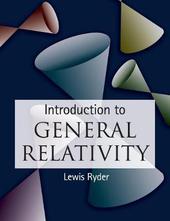
|
Introduction to General Relativity
Paperback / softback
Main Details
| Title |
Introduction to General Relativity
|
| Authors and Contributors |
By (author) Lewis Ryder
|
| Physical Properties |
| Format:Paperback / softback | | Pages:457 | | Dimensions(mm): Height 245,Width 187 |
|
| Category/Genre | Cosmology and the universe
Relativity physics |
|---|
| ISBN/Barcode |
9781108798372
|
| Classifications | Dewey:530.11 |
|---|
| Audience | | Tertiary Education (US: College) | | Professional & Vocational | |
|---|
| Illustrations |
Worked examples or Exercises; 1 Halftones, unspecified
|
|
Publishing Details |
| Publisher |
Cambridge University Press
|
| Imprint |
Cambridge University Press
|
| Publication Date |
16 January 2020 |
| Publication Country |
United Kingdom
|
Description
A student-friendly style, over 100 illustrations, and numerous exercises are brought together in this textbook for advanced undergraduate and beginning graduate students in physics and mathematics. Lewis Ryder develops the theory of general relativity in detail. Covering the core topics of black holes, gravitational radiation, and cosmology, he provides an overview of general relativity and its modern ramifications. The book contains chapters on gravitational radiation, cosmology, and connections between general relativity and the fundamental physics of the microworld. It explains the geometry of curved spaces and contains key solutions of Einstein's equations - the Schwarzschild and Kerr solutions. Mathematical calculations are worked out in detail, so students can develop an intuitive understanding of the subject, as well as learn how to perform calculations. The book also includes topics concerned with the relation between general relativity and other areas of fundamental physics. Selected solutions for instructors are available under Resources.
Author Biography
Lewis Ryder is an Honorary Senior Lecturer in Physics at the University of Kent, UK. His research interests are in geometrical aspects of particle theory and its parallels with general relativity.
Reviews'This superb and spirited modern introduction to Einstein's theory of gravitation covers all of the essential topics with admirable clarity. A penetrating discussion of the basic concepts of the theory is followed by a wonderfully lucid development of the mathematical formalism using modern differential geometry. Ample illustrations and problems enhance and complement the text; moreover, a generous list of references is provided at the end of each chapter for further reading. This scholarly yet accessible textbook is highly recommended for a course on general relativity.' Bahram Mashhoon, University of Missouri 'This book offers a lucid introduction to Einstein's theory of gravitation which is finally part of mainstream physics in many undergraduate final year options. The style is pedagogic and notable for a gentle but concise introduction to modern calculational tools in applied differential geometry along with traditional tensor calculus. The student will surely find the careful attention to detail in the many explicit computations of advanced topics (such as action principles, pseudo-tensors, gravito-magnetism and the Dirac equation in a curved space-time) of immense help in developing an understanding of general relativity. The book provides a welcome fresh approach for all students wishing to take the subject further.' Robin Tucker, Lancaster University 'Lewis Ryder, an exceptionally fine teacher ... has written a lucid account of the subject, suitable for undergraduates familiar with the special theory. In this handsomely produced volume, Ryder develops the subject from its simple principles into a mathematical edifice of unsurpassed mathematical beauty.... I would recommend anyone teaching this subject to take a look at this text, a strong candidate for the best treatment on the market.... extremely thorough and clear ... this could emerge as a market leader in a crowded field.' The Times Higher Education Supplement 'This modern and inspiring textbook is highly recommended not only for a course on general relativity, but also to those who wish to learn this exciting subject by a self-study.' Annalen der Physik 'On the whole, the selection of the material and the general structure of the book is quite traditional. The two notable exceptions are the careful exposition of gravitomagnetism and the informative discussion of the gauge approach to gravity; both topics are not usually included in textbooks on general relativity ... I enjoyed ... reading this book [a lot]. Written with great care and accuracy in a lively and beautiful style ... [it] will be undoubtedly appreciated by students, researchers and lecturers.' General Relativity and Gravitation
|